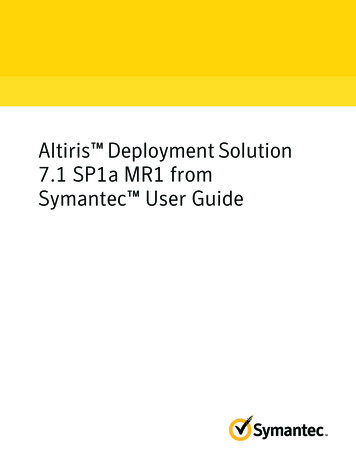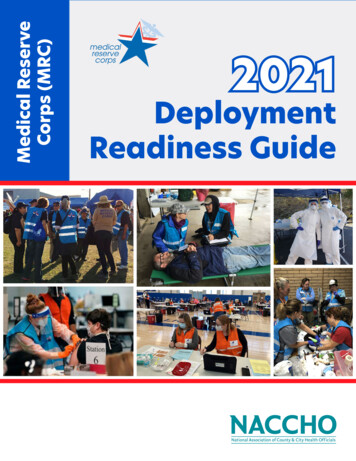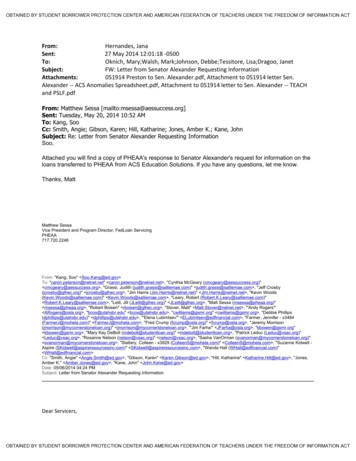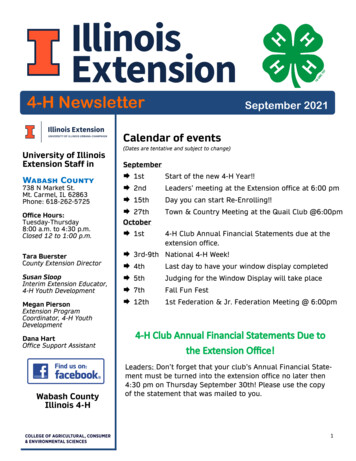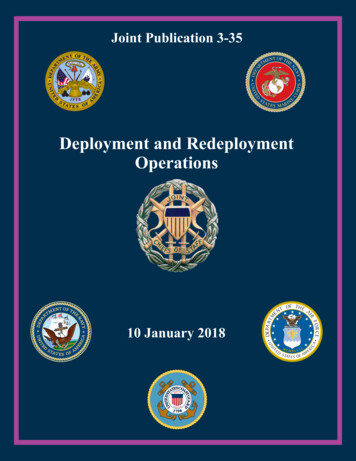
Transcription
ENHITTMT OF T HS W E' L LDEFEENDARDSTMTEERU NII CA MY DE PARJoint Publication 3-35AT E S O FADeployment and RedeploymentOperations10 January 2018
PREFACE1. ScopeThis publication provides joint doctrine to plan, execute, and assess deployment andredeployment operations.2. PurposeThis publication has been prepared under the direction of the Chairman of the JointChiefs of Staff (CJCS). It sets forth joint doctrine to govern the activities and performanceof the Armed Forces of the United States in joint operations, and it provides considerationsfor military interaction with governmental and nongovernmental agencies, multinationalforces, and other interorganizational partners. It provides military guidance for the exerciseof authority by combatant commanders and other joint force commanders (JFCs), andprescribes joint doctrine for operations and training. It provides military guidance for useby the Armed Forces in preparing and executing their plans and orders. It is not the intentof this publication to restrict the authority of the JFC from organizing the force andexecuting the mission in a manner the JFC deems most appropriate to ensure unity of effortin the accomplishment of objectives.3. Applicationa. Joint doctrine established in this publication applies to the Joint Staff, commandersof combatant commands, subordinate unified commands, joint task forces, subordinatecomponents of these commands, the Services, and combat support agencies.b. The guidance in this publication is authoritative; as such, this doctrine will befollowed except when, in the judgment of the commander, exceptional circumstancesdictate otherwise. If conflicts arise between the contents of this publication and thecontents of Service publications, this publication will take precedence unless the CJCS,normally in coordination with the other members of the Joint Chiefs of Staff, has providedmore current and specific guidance. Commanders of forces operating as part of amultinational (alliance or coalition) military command should follow multinationaldoctrine and procedures ratified by the United States. For doctrine and procedures notratified by the US, commanders should evaluate and follow the multinational command’sdoctrine and procedures, where applicable and consistent with US law, regulations, anddoctrine.For the Chairman of the Joint Chiefs of Staff:KEVIN D. SCOTTVice Admiral, USNDirector, Joint Force Developmenti
PrefaceIntentionally BlankiiJP 3-35
SUMMARY OF CHANGESREVISION OF JOINT PUBLICATION 3-35DATED 31 JANUARY 2013 Refines the distribution process owner and Global Distribution Synchronizerinto the Joint Deployment and Distribution Coordinator role in accordancewith the Unified Command Plan. Refines Adaptive Planning and Execution (APEX) overview. Refines the Secretary of Defense (SecDef) role in Global Force ManagementAllocation Plan process. Expands combatant commanders roll in execution sourcing under globalforce management allocation process. Updates the Joint Deployment and Redeployment Process figure to reflect thedeployment or redeployment as the initiation point. Updates functional combatant commands to remove global synchronizer andreplace with coordinating authority. Expands asset visibility capabilities to include Global Combat SupportSystem-Joint and Integrated Data Environment/Global TransportationNetwork Convergence as both providing in-transit visibility. Clarifies Title 10, Unite States Code, Section 162, SecDef direction to assignand allocate forces. Updates Military Planning and Execution Process figure to incorporatetheater distribution campaign plan under planning products. Refines the deployment/redeployment planning and APEX processes. Refines the combatant command roles and responsibilities in the movementphase of the joint deployment and redeployment process. Updates port of embarkation to reflect Military Surface Deployment andDistribution Command no longer has deployment support teams. Refines integration overview to highlight the importance and ongoing natureof integration with the joint, reception, staging, onward movement, andintegration phase of deployment.iii
Summary of ChangesIntentionally BlankivJP3-35
TABLE OF CONTENTSEXECUTIVE SUMMARY . viiCHAPTER IOVERVIEW Introduction . I-1Adaptive Planning and Execution. I-1Global Force Management . I-4Joint Deployment and Redeployment Processes . I-5CHAPTER IIRESPONSIBILITIES General .II-1Secretary of Defense .II-1Chairman of the Joint Chiefs of Staff .II-2Combatant Commanders and Force Providers .II-4Functional Combatant Commands .II-8Military Departments and National Guard Bureau .II-11Department of Defense Agencies .II-14Other United States Government Departments and Agencies .II-16Other Transportation Partners or Providers .II-18CHAPTER IIIPLANNING General . III-1Considerations of Operational Requirements . III-2Deployment/Redeployment Planning and Adaptive Planning and Execution . III-6CHAPTER IVPREDEPLOYMENT AND PRE-REDEPLOYMENT ACTIVITIES General . IV-1Deployment Prepare the Force Activities . IV-1Schedule Movement for Deployment . IV-4Assemble and Marshal Forces for Deployment . IV-5Redeployment Prepare the Force Activities . IV-6Schedule Movement for Redeployment. IV-7Assemble and Marshal Forces for Redeployment . IV-8CHAPTER VMOVEMENT General . V-1Movement Considerations . V-1v
Table of Contents Movement Control . V-3Movement . V-6Force Visibility . V-8Redeployment . V-12CHAPTER VIJOINT RECEPTION, STAGING, ONWARD MOVEMENT, AND INTEGRATION General . VI-1Principles of Joint Reception, Staging, Onward Movement, and Integration . VI-3Elements of Joint Reception, Staging, Onward Movement, and Integration. VI-4Reception . VI-7Staging . VI-17Onward Movement . VI-19Integration . VI-24APPENDIXABCDInformation Technology Enabling Tools . A-1Sample Time-Phased Force and Deployment Data Letter of Instruction .B-1References .C-1Administrative Instructions . D-1GLOSSARYPart IPart IIAbbreviations, Acronyms, and Initialisms . GL-1Terms and Definitions . I-5VI-6VI-7viAdaptive Planning and Execution Enterprise. I-2Military Planning and Execution Process . I-3Joint Deployment and Redeployment Processes . I-6The Strategic Mobility Triad . I-8Example of Infrastructure Assessment . III-5Force Visibility . V-9In-Transit Visibility . V-11Elements of Joint Reception, Staging,Onward Movement, and Integration . VI-4Joint Reception, Staging, Onward Movement, and Integration SupportConsiderations . VI-6Aerial Port of Debarkation Support Functions . VI-10Seaport of Debarkation Functions . VI-11Port Support Activity and Port Operations Group Functions . VI-12Staging Force-Related Activities . VI-18Host-Nation Support to Onward Movement . VI-24JP 3-35
EXECUTIVE SUMMARYCOMMANDER’S OVERVIEW Discusses the use of global force management to assign, allocate, andapportion joint forces. Outlines the joint deployment and redeployment processes. Identifies the deployment and redeployment responsibilities, roles, andrelationships of individuals, commands, Services and agencies. Describes the planning phase of the deployment and redeployment process. Addresses the activities taken to prepare forces to execute adeployment/redeployment operation before actual movement. Describes the movement phase of the joint deployment and redeploymentprocess. Presents an overview of the final phase of deployment and redeployment,joint reception, staging, onward movement, and integration.OverviewThe deployment and redeployment of US forcesin support of combatant commander (CCDR)requirements are a series of operational eventsenabled by logistics. These activities areplanned and executed by the supported andsupporting commands, Services, NationalGuard Bureau, and Department of Defense(DOD) agencies.Adaptive Planning and Execution The Adaptive Planning and Execution (APEX)enterprise integrates the force and joint planningactivities of the joint planning and executioncommunity (JPEC) and facilitates the transitionfrom planning to execution.The APEX enterprise, via the military planningand execution process, has four operationalactivities: situational awareness, planning,execution, and assessment. The members of JPECare continuously performing the operationalactivities and iteratively linking those activitieswith the planning and execution functions.vii
Executive SummaryGlobal Force ManagementGlobal Force Management allows the Secretary ofDefense (SecDef) to strategically manage theemployment of the force among CCDRs. It alignsforce assignment, allocation, and apportionmentmethodologies in support of the Defense StrategyReview, joint force availability requirements, andjoint force assessments.Joint Deployment andRedeployment ProcessesThe joint deployment and redeployment processesconsist of four phases: planning; predeployment/preredeployment activities; movement; and jointreception, staging, onward movement, andintegration (JRSOI). These phases are iterative andmay occur simultaneously throughout an operation.ResponsibilitiesSecretary of DefenseSecDef provides directive authority to the CCDRsfor the planning and execution of military operations,to include deployment and redeployment operations,as directed by the President.Chairman of the Joint Chiefs ofStaffChairman of the Joint Chiefs of Staff’sresponsibilities most directly related todeployment operations include the following: Combatant Commanders andForce ProvidersSupported CCDRs have three s: viiiPrepares integrated plans for militarymobilization.Establishes procedures for the submission ofmovement requirements.Prescribes a movement priority system inagreement with uniform materiel movementand issue priority system that will ensureresponsiveness to meet the needs of the CCDR.Advises SecDef of mobility support forcecapabilities and assesses their impact on CCDRand DOD component requirements.Build a time-phased force and deploymentdata (TPFDD) based on the concept ofoperations and, subsequently, validatemovement requirements in the TPFDD afterJP 3-35
Executive Summary the unit refined movement data has beenentered;Determine predeployment standards; andBalance and regulate the transportation flow.Responsibilities of Supporting CCDRs: Supporting missions of the joint force couldinclude sponsorship of en route basing or intransit staging areas (SAs), or provision ofsustainment from theater stocks;Regardless of the supporting mission, theprimary task for supporting combatantcommands (CCMDs) is to ensure thesupported CCDR receives the timely andcomplete support needed to accomplish themission.In addition to the supporting CCDRresponsibilities described above, a CCDRmay also have additional responsibilities as aforce provider (FP) of allocated forces.Functional CombatantCommandsFunctional CCDRs provide planning andassessment support to geographic combatantcommanders to ensure the alignment andharmonization of campaign plans across area ofresponsibilityandfunctionalboundaries.Normally, several functional CCMDs are involvedin every phase of a joint operation. Threefunctional CCMDs involved in deployment of thejoint force are: US Special Operations Command,US Strategic Command, and United StatesStrategic Command (USTRANSCOM).Military Departments andNational Guard BureauThe Military Departments organize, train, supply,equip, maintain, mobilize, account for, and provideadministrative and logistics support (includingService-organic transportation) for their respectiveforces. When acting as an FP, the Secretaries ofthe Military Departments coordinate directly withCCMDs, joint FPs, and the Joint ForceCoordinator to develop recommended globalsourcing solutions. Each Service is responsible foradministrative support and performance oftransportation operations assigned by CCDRs atix
Executive Summaryeither their local shippingthroughout the theater.installationsorPlanningDeployment planning activities include all actionsrequired for the deployment of forces up to thepoint of their employment. It involves planning tomove, receive, and integrate forces from origin tofinal destination. Under the execution function ofAPEX, forces are allocated, sourced, andmobilized using readiness analysis. Sustainment isrequisitioned or pre-positioned and forcesscheduled in the TPFDD.Considerations of OperationalRequirementsWhen conducting deployment planning, thefollowing operational requirements should beconsidered: Deployment/RedeploymentPlanning and Adaptive Planningand ExecutionExisting distribution plans.Threat environment.Communications systems supporting visibilityof deployment operations.Training.Infrastructure assessment.Host-nation support.Operational contract support.Seabasing.APEX leverages a number of tools and processes.Information technology tools enable plannercollaboration and access to shared authoritativedata. Complementary tools of the overall planningprocess provide planners flexible analyticaltechniques for framing problems and logicallydeveloping plans or orders to accomplish missionsand objectives, more specifically the deploymentand redeployment operations.Predeployment and Pre-Redeployment ActivitiesPredeployment and pre-redeployment activities arethe second phase in the joint deployment andredeployment process. A majority of thesefunctions are performed at the unit level, linkingxJP 3-35
Executive Summarythe installation/base/unit deployment/redeploymentefforts to the overall strategic movement.Deployment Prepare the ForceActivitiesRegardless of the deployment timeline, a myriad ofpredeployment activities must be accomplished todeploy the force with their required equipment andsupplies.Deployment timelines will dictate available time toconduct prepare the force activities, which include:activating deployment and command and control(C2) support organizations, conducting movementand support meetings, developing unit deploymentlists and identifying shipping/handling requirements,and conducting required training.Schedule Movement forDeploymentMovement scheduling is an iterative process done atevery level of supported and supporting commandsto transport, move, or deploy the right forces (unitrelated personnel and equipment) and equipment) to the right place at the right time.Schedule movement consists of five activities: Receive strategic movement schedule.Receive/assess movement and lift schedule.Receive port calls.Confirm movement clearances.Build and publish schedule of events.Assemble and Marshal Forces for Assembly and marshalling involve bringingtogether personnel, supplies, and equipment inDeploymentpreparation for final movement to the port ofdebarkation (POD). It comprises four activities: Redeployment Prepare the ForceActivitiesAssemble personnel and cargo.Conduct unit inspection, load equipment, andprepare.Sequence loads.Establish support organization at the port ofembarkation (POE).A successful redeployment requires the planningand execution of “prepare the force” activitiessimilar to those used in deployments. The executionof these pre-redeployment activities will not bexi
Executive Summaryidentical to deployment activities due to theoperational environment, available resources, andthe force structure of the redeploying units. Assuch, procedures and unit level activities may varyfrom those performed during a deployment butthese activities require detailed planning for asuccessful redeployment operation. Redeploymentprepare the force activities also has a unique sixthactivity, complete equipment disposition actions.Schedule Movement forRedeploymentThe five schedule movement activities discussedfor deployment are also applicable toredeployment. Normally, notional redeploymentTPFDDs are developed during redeploymentplanning and updated and refined during executionas the redeployment window approaches.Assemble and Marshal Forces for These redeployment activities are the same asthose performed during deployment and mayRedeploymentrequire additional time and locations. There is alsoan additional redeployment activity: prepare andconduct customs/agricultural inspections.MovementThe movement phase of the joint deployment andredeployment process includes self-deployingforces and forces requiring lift support and iscomposed of movement from origin to POE, POEoperations, and movement from the POE to POD.However, for joint deployment to produce aseamless, end-to-end deployment movementprocess, consideration should be given tomovement that extends beyond the POD.Movement ConsiderationsDuring deployment or redeployment, forcesrequiring movement comprise three generalcategories: self-deploying forces, forces requiringintertheater and intratheater common-user airliftsupport, and unit movements involving acombination of self-deployment and common-userairlift support.Movement ControlMovement control coordinates transportationresources to enhance combat effectiveness and meetthe deployment/redeployment and sustainmentpriorities of the supported CCDR.EffectivexiiJP 3-35
Executive Summarymovement control during deployment operationsprovides the joint force commander (JFC) with thecapability to monitor and manage movementexecution and adjust the flow of forces and materielas necessary. It provides for mechanisms tocoordinate and deconflict movements and prioritiesfor limited road space, constrained common-userairlift assets, and cross boundary/activities.MovementValidated movement requirements developed duringthe deployment planning phase and scheduled formovement during predeployment activities phase aremoved by some mode of transportation from point oforigin to designated aerial port of embarkation(APOE)/seaport of embarkation (SPOE) (when notco-located). The supported CCMD selects theAPOE/SPOE as a part of the validation process incoordination with its components, USTRANSCOM,and FPs outside the continental US. APOEs/SPOEsare selected by the supported CCMD in coordinationwith its components, FPs, and USTRANSCOM.Airlift and sealift schedules are prepared byUSTRANSCOM and coordinated with the supportedCCMD.Force VisibilityVisibility of deploying forces and materiel isestablished through the logistics managementconstruct of asset visibility (AV) and the GlobalCommand and Control System-Joint (GCCS-J)common operational picture. AV is possible throughintegration of the capabilities provided by automaticidentification technology; in-transit visibility; and theinformation systems and decision support toolscomprising the Integrated Data Environment/GlobalTransportation Network Convergence, GlobalCombat Support System-Joint, single mobilitysystem, and the Web Scheduling and Movement subsystem of the Joint Operation Planning andExecution System. Control of the deployment andredeployment processes is exercised through the C2capabilities of GCCS-J.RedeploymentMovement in support of redeployment relocatesforces to support a new mission in anotheroperational area (OA) or to return them to theirhome or demobilization station.xiii
Executive SummaryJoint Reception, Staging, Onward Movement, and IntegrationThe JRSOI phase of the deployment/redeploymentprocess facilitates the transition between theexecution functions of deployment andemployment.The four segments of JRSOI are: Reception operations include all those functionsrequired to receive and clear personnel,equipment, and materiel through the POD.Staging assembles, temporarily holds, andorganizes arriving personnel, equipment, andmateriel into forces and capabilities andprepares them for onward movement, tacticaloperations, or Service reintegration.Onward movement is the process of movingforces, capabilities, and accompanying materielfrom reception facilities, marshalling areas, andSAs to tactical assembly areas (TAAs) and/orOAs or onward from the POD or other receptionareas to the home/demobilization station.Integration is the synchronized transfer ofcapabilities into an operational commander’sforce prior to mission execution or back to thecomponent/Service.Principles of Joint Reception,Staging, Onward Movement, andIntegrationThere are three overarching principles of JRSOI:unity of command, synchronization, and balance.Elements of Joint Reception,Staging, Onward Movement, andIntegrationJRSOI relies on the essential elements ofcommunication systems, force protection, andsupport organizations and structures to achieveunity of command, synchronization, and balance.ReceptionReception is the process of receiving, off-loading,marshalling, and transporting of personnel,equipment, and materiel from strategic and/orintratheater deployment phase to a sea, air, orsurface transportation POD to the marshalling area.StagingRegardless of where staging occurs, the activitiesassociated with staging will generally includeassembling, temporary holding, and organizing ofarriving personnel, equipment, and materiel intoxivJP 3-35
Executive Summaryunits and forces and preparing them for onwardmovement and employment by the JFC. Duringstaging, deploying forces have limited missioncapability and may not be self-sustainable. TheCCDR should provide facilities, sustainment, lifesupport, and protection until deploying units regaintheir combat or mission capability.Onward MovementOnward movement is the process of moving forcesand sustainment from reception facilities andmarshalling or SAs to TAAs or other operatingareas. Rail, road, inland or coastal waterway, and/orair can be used to accomplish this movement as mayintra-theater lift.Challenges associated withonward movement during a deployment orredeployment to a new OA may include unications (LOC) capacity, degraded LOCconditions, the potential for enemy interdiction, andreporting and movement control procedures.IntegrationDuring deployment or redeployment to a new OA,integration is the synchronized transfer of missionready forces and capabilities into the CCDR’s forceand, based on the complexity of the operation, maytake hours or days to complete. The complexity andtime required for integration depends on the size,contingency conditions, coordination and planning,C2 communications, and security available tomanage the deploying or redeploying force.Integration is complete when the receivingcommander establishes C2 over the arriving unitand the unit is capable of performing its assignedmission.CONCLUSIONThis publication provides joint doctrine to plan,execute, and assess deployment and redeploymentoperations.xv
Executive SummaryIntentionally BlankxviJP 3-35
CHAPTER IOVERVIEW1. Introductiona. The US employs the four instruments of national power (diplomatic, informational,military, and economic) to achieve national strategic objectives. The military instrument’srole increases relative to the other instruments as the need to compel an adversary throughforce increases. Military efforts focus on fielding modular, adaptive forces that can beemployed across the range of military operations. Deployment and redeploymentoperations enable the projection of the military instrument of national power. Joint forcesdeploy in support of ongoing operations and theater and functional campaign planactivities.b. The deployment and redeployment of US forces in support of combatantcommander (CCDR) requirements are a series of operational events enabled by logistics.These activities are planned and executed by both the supported and supporting commands,Services, National Guard Bureau (NGB), and Department of Defense (DOD) agencies.The capability to deploy forces to the operational area (OA) and rapidly integrate them intothe joint force, as directed by the joint force commander (JFC), is essential. Missionrequirements determine the scope, duration, and scale of deployment and redeploymentoperations. These operations involve the integrated complementary efforts of numerouscommands, Services, agencies, and processes, and as such, unity of effort is required foreffective and efficient mission accomplishment.2. Adaptive Planning and ExecutionThe Adaptive Planning and Execution (APEX) enterprise (Figure I-1) integrates theforce and joint planning activities of the joint planning and execution community (JPEC)and facilitates the transition from planning to execution. APEX operational activities andfunctions span many organizations at all levels of the chain of command. Collaborationamong the supported and supporting commands, Services, and other organizations is anessential element of APEX to achieve unified action. APEX informs the entire chain ofcommand, including the President and Secretary of Defense (SecDef), facilitating informeddecisions on how, when, and where to employ the military. APEX is applicable across therange of military operations to plan and execute military activities to achieve the policyobjectives outlined in the National Security Strategy and National Military Strategy.APEX provides the process, structure, reports, plans, and orders that orchestrate theemployment of the military instrument of national power. In accordance with (IAW)SecDef directive, APEX is used for planning and executing all deployment andredeployment operations.a. The APEX enterprise, via the military planning and execution process (Figure I-2),has four operational activities: situational awareness, planning, execution, and assessment.The members of JPEC are continuously performing the operational activities anditeratively linking those activities with the planning and execution functions. Whenperforming the planning functions, JPEC may use problem-solving techniques adapted forI-1
Chapter IAdaptive Planning and Execution EnterpriseUpdates to Strategic Guidance based on common understanding ofthe dynamics of the situation, approach, resources, costs, and risks.National InterestsPresidenti
Adaptive Planning and Execution The Adaptive Planning and Execution (APEX) enterprise integrates the force and joint planning activities of the joint planning and execution community (JPEC) and facilitates the transition from planning to execution. The APEX enterprise, via the military planning and execution process, has four operational
